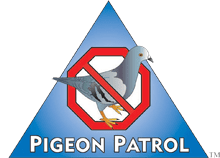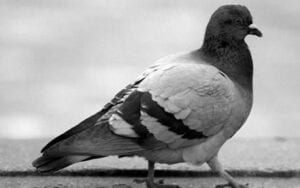
by Pigeon Patrol | May 25, 2021 | Bird Deterrent Products, Bird Law, Bird Netting, Bird Spikes, Pigeon Control, Pigeon Droppings, Pigeon Patrol's Services
When it comes to birds, there may be more than just avian flu to be worried about. It has been suggested that there are over 60 other diseases that birds and their droppings can carry. The problem is especially worrisome in residential areas, as many of them are airborne and can be transferred to humans just by being around droppings.
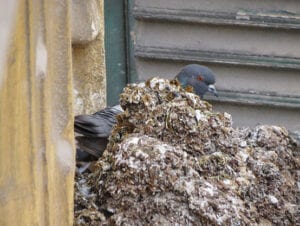
a pigeon bird standing by guano manure
Chicken farms can be fairly easily secured. With a combination of visual scare devices, sonic distress call emitters, ultrasonic disrupters and roost inhibitors other birds shouldn’t be a problem. If farmers just took this preventative action it could help contain the bird flu outbreak a good deal.
- Histoplasmosis is a respiratory disease that may be fatal. It results from a fungus growing in dried bird droppings.
- Candidiasis is a yeast or fungus infection spread by pigeons. The disease affects the skin, the mouth, the respiratory system, the intestines and the urogenital tract, especially the vagina. It is a growing problem for women, causing itching, pain and discharge.
- Cryptococcosis is caused by yeast found in the intestinal tract of pigeons and starlings. The illness often begins as a pulmonary disease and may later affect the central nervous system. Since attics, cupolas, ledges, schools, offices, warehouses, mills, barns, park buildings, signs, etc. are typical roosting and nesting sites, the fungus is apt to found in these areas.
- St. Louis Encephalitis, an inflammation of the nervous system, usually causes drowsiness, headache and fever. It may even result in paralysis, coma or death. St. Louis encephalitis occurs in all age groups, but is especially fatal to persons over age 60. The disease is spread by mosquitoes which have fed on infected house sparrow, pigeons and house finches carrying the Group B virus responsible for St. Louis encephalitis.
- Salmonellosis often occurs as “food poisoning” and can be traced to pigeons, starlings and sparrows. The disease bacteria are found in bird droppings; dust from droppings can be sucked through ventilators and air conditioners, contaminating food and cooking surfaces in restaurants, homes and food processing plants.
- E.coli. Cattle carry E. coli 0157:H7. When birds peck on cow manure, the E. coli go right through the birds and the bird droppings can land on or in a food or water supply.
Besides being direct carriers of disease, nuisance birds are frequently associated with over 50 kinds of ectoparasites, which can work their way throughout structures to infest and bite humans. About two-thirds of these pests may be detrimental to the general health and well-being of humans and domestic animals. The rest are considered nuisance or incidental pests.
A few examples of ectoparasites include:
- Bed bugs (Cimex lectularius) may consume up to five times their own weight in blood drawn from hosts which include humans and some domestic animals. In any extreme condition, victims may become weak and anemic. Pigeons, starlings and house sparrows are known to carry bed bugs.
- Chicken mites (Dermanyssus gallinae) are known carriers of encephalitis and may also cause fowl mite dermatitis and acariasis. While they subsist on blood drawn from a variety of birds, they may also attack humans. They have been found on pigeons, starlings and house sparrows.
- Yellow mealworms (Tenebrio molitor), perhaps the most common beetle parasites of people in the United States, live in pigeon nests. It is found in grain or grain products, often winding up in breakfast cereals, and may cause intestinal canthariasis and hymenolespiasis.
- West Nile Virus while West Nile is technically not transmitted to humans from birds, humans can get infected by the bite of a mosquito who has bitten an infected bird. The obvious lesson is that the fewer birds there are in any given area, the better. This translates into a smaller chance of an infected bird in that area, a smaller chance of a mosquito biting an infected bird and then biting a human.
Pigeon Patrol Products & Services is the leading manufacturer and distributor of bird deterrent (control) products in Canada. Pigeon Patrol products have solved pest bird problems in industrial, commercial, and residential settings since 2000, by using safe and humane bird deterrents with only bird and animal friendly solutions. At Pigeon Patrol, we manufacture and offer a variety of bird deterrents, ranging from Ultra-flex Bird Spikes with UV protection, Bird Netting, 4-S Bird Gel and the best Ultrasonic and audible sound devices on the market today.
Voted Best Canadian wholesaler for Bird Deterrent products ten years in a row.
Contact us at 1- 877– 4– NO-BIRD, (604) 585-9279 or visit our website at www.pigeonpatrol.ca
Pigeon/Pigeon Patrol / Pigeons Roosting / Vancouver Pigeon Control /Bird Spikes / Bird Control / Bird Deterrent / Pigeon Deterrent? Surrey Pigeon Control / Pest /Seagull deterrent / Vancouver Pigeon Blog / Birds Inside Home / Pigeons in the cities / Ice Pigeons/ What to do about pigeons/ sparrows , Damage by Sparrows, How To Keep Raccoons Away, Why Are Raccoons Considered Pests/ De-fence / Pigeon Nesting/ Bird Droppings / Pigeon Dropping/ woodpecker control/ Professional Bird Control Company/ Keep The Birds Away/ Birds/rats/ seagull/pigeon/woodpecker/ dove/sparrow/pidgeon control/pidgeon problem/ pidgeon control/flying rats/ pigeon Problems/ bird netting/bird gel/bird spray/bird nails/ bird guard
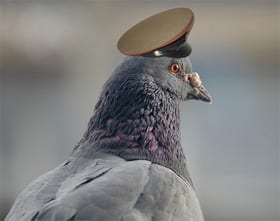
by Pigeon Patrol | May 25, 2021 | Bird Law, Columbidae, pet bird, Pigeon Predators, Pigeons in the News, Sparrows
Found in a field in mid-September by a couple out hiking in Ingersheim, northeastern France, the message was sent from one German military officer to another in 1910, when the area was still part of Germany, according to Dominique Jardy, curator of the nearby Linge Memorial museum.
Jardy told CNN the message was folded up inside a small aluminum capsule and the script is difficult to decipher.
A German friend, whom Jardy asked to translate the message, said the officer, who was based in the town of Colmar, is recounting German military exercises in the area.
“Platoon Potthof receives fire as they reach the western border of the parade ground, platoon Potthof takes up fire and retreats after a while,” the message reads, according to the AFP news agency. “In Fechtwald half a platoon was disabled. Platoon Potthof retreats with heavy losses.”
These losses are an estimate based on the war games rather than actual deaths, said Jardy, explaining that this is common practice during military exercises.
Difficulty in reading the script means there is some debate about whether the message was sent in 1910 or 1916. However, Jardy is convinced it is the former because he is not aware of any military maneuvers around Colmar in 1916, and the note uses terms specific to military exercises rather than warfare.
Artifacts like the message are almost never found today, Jardy said.
“It’s really very, very, very rare,” he said. “It’s really exceptional.”
The message will now go on display at the Linge Memorial museum, which tells the story of a battle between French and German forces in 1915.
France ceded Ingersheim and the surrounding area to Germany in 1871 after the Franco-German war, but the territory changed hands again in 1918 with the Allied victory in World War I.
Pigeon Patrol Products & Services is the leading manufacturer and distributor of bird deterrent (control) products in Canada. Pigeon Patrol products have solved pest bird problems in industrial, commercial, and residential settings since 2000, by using safe and humane bird deterrents with only bird and animal friendly solutions. At Pigeon Patrol, we manufacture and offer a variety of bird deterrents, ranging from Ultra-flex Bird Spikes with UV protection, Bird Netting, 4-S Bird Gel and the best Ultrasonic and audible sound devices on the market today.
Voted Best Canadian wholesaler for Bird Deterrent products ten years in a row.
Contact us at 1- 877– 4– NO-BIRD, (604) 585-9279 or visit our website at www.pigeonpatrol.ca
Pigeon/Pigeon Patrol / Pigeons Roosting / Vancouver Pigeon Control /Bird Spikes / Bird Control / Bird Deterrent / Pigeon Deterrent? Surrey Pigeon Control / Pest /Seagull deterrent / Vancouver Pigeon Blog / Birds Inside Home / Pigeons in the cities / Ice Pigeons/ What to do about pigeons/ sparrows , Damage by Sparrows, How To Keep Raccoons Away, Why Are Raccoons Considered Pests/ De-fence / Pigeon Nesting/ Bird Droppings / Pigeon Dropping/ woodpecker control/ Professional Bird Control Company/ Keep The Birds Away/ Birds/rats/ seagull/pigeon/woodpecker/ dove/sparrow/pidgeon control/pidgeon problem/ pidgeon control/flying rats/ pigeon Problems/ bird netting/bird gel/bird spray/bird nails/ bird guard
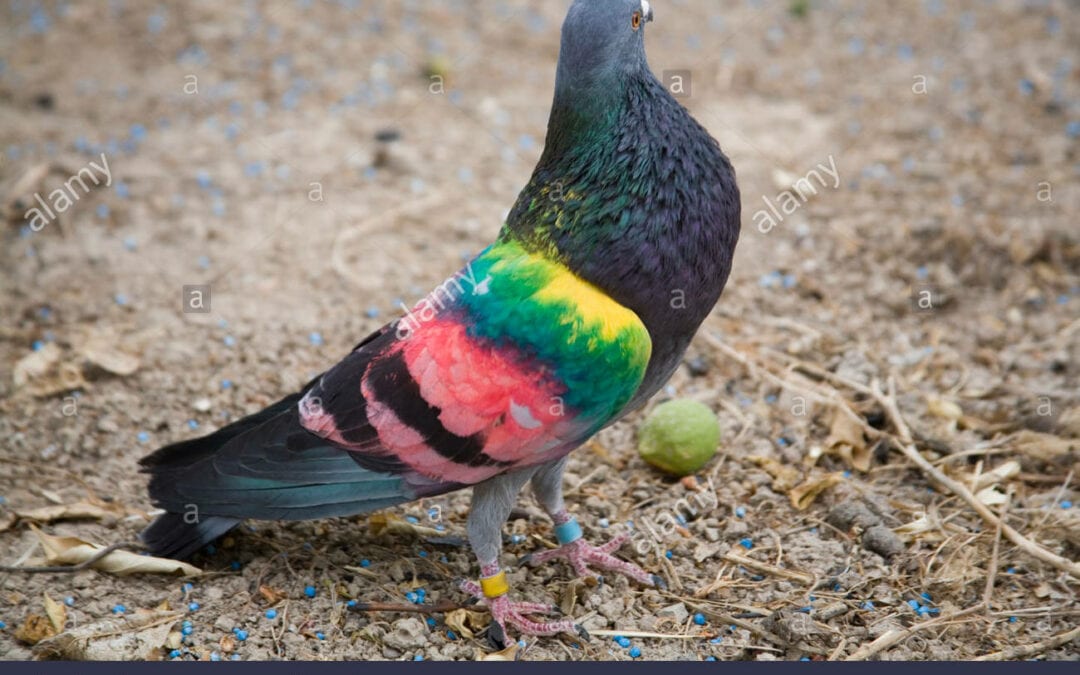
by Pigeon Patrol | May 17, 2021 | Bird Law, Doves, history of pigeons, pet bird, Pigeon Control
Earth’s magnetic field plays a vital role in everything from animal migration to protecting the Earth from the Sun’s harsh solar wind. Now, a recent study finally sheds light on how some birds visually see Earth’s magnetic field. Birds use Earth’s magnetic field as sort of a heads-up display to help them navigate the globe.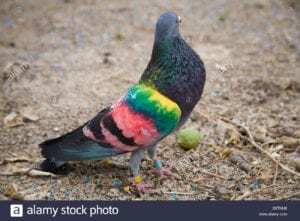
The Earth’s magnetic field is a result of the movement or convection of liquid iron in the outer core. As the liquid metal in the outer core moves, it generates electric currents, which lead to a magnetic field. The continual movement of liquid metal through this magnetic field creates stronger electrical currents and thus a stronger magnetic field. This positive feedback loop is called the geomagnetic dynamo.
While scientists have known for quite some time that birds can see Earth’s magnetic field, it was unclear exactly how birds are able to visualize the magnetic field. Two recent studies from researchers at Lund University in Sweden and Carl von Ossietzky University Oldenburg in Germany discovered that the ability is a result of a special protein in bird’s eyes. The two papers studied European robins and zebra finches and found evidence for an unusual eye protein called Cry4.
The Cry4 protein is part of a class of protein called a cryptochrome that is sensitive to blue light. Cryptochromes are found in both plants and animals and are responsible for circadian rhythms in various species. In the two bird species above, it appears that the presence of cryptochromes, specifically the Cry4 protein, is responsible for the ability of birds to visually detect Earth’s magnetic field.
The ability to see Earth’s magnetic field, known as magnetoreception, relies on the presence of specifically the blue wavelength of light. The complex process involves “radical” intermediate molecules which are sensitive to Earth’s magnetic field. The Earth’s magnetic field, as it relates to the direction the bird is facing, could alter the intermediate radical molecules differently, giving the bird a sense for where it is facing in relation to the Earth’s magnetic field.
The research team also found that the Cry4 protein was produced in much higher amounts in European robins during migration season. Perhaps this would give the robin a more precise picture of Earth’s magnetic field throughout its migration.
While the exact way birds visualize Earth’s magnetic field is part of further investigation, scientists believe the Cry4 protein acts as sort of a filter over the bird’s vision. This filter would allow birds to see a sort of compass of the Earth and direct their migratory flights accordingly.
Scientists at the University of Illinois at Urbana-Champaign believe birds see Earth’s magnetic field through a filter similar to the figure above. This would act to guide birds in the right direction through migration.
Source
Pigeon Patrol Products & Services is the leading manufacturer and distributor of bird deterrent (control) products in Canada. Pigeon Patrol products have solved pest bird problems in industrial, commercial, and residential settings since 2000, by using safe and humane bird deterrents with only bird and animal friendly solutions. At Pigeon Patrol, we manufacture and offer a variety of bird deterrents, ranging from Ultra-flex Bird Spikes with UV protection, Bird Netting, 4-S Bird Gel and the best Ultrasonic and audible sound devices on the market today.
Voted Best Canadian wholesaler for Bird Deterrent products ten years in a row.
Contact us at 1- 877– 4– NO-BIRD, (604) 585-9279 or visit our website at www.pigeonpatrol.ca
Pigeon/Pigeon Patrol / Pigeons Roosting / Vancouver Pigeon Control /Bird Spikes / Bird Control / Bird Deterrent / Pigeon Deterrent? Surrey Pigeon Control / Pest /Seagull deterrent / Vancouver Pigeon Blog / Birds Inside Home / Pigeons in the cities / Ice Pigeons/ What to do about pigeons/ sparrows , Damage by Sparrows, How To Keep Raccoons Away, Why Are Raccoons Considered Pests/ De-fence / Pigeon Nesting/ Bird Droppings / Pigeon Dropping/ woodpecker control/ Professional Bird Control Company/ Keep The Birds Away/ Birds/rats/ seagull/pigeon/woodpecker/ dove/sparrow/pidgeon control/pidgeon problem/ pidgeon control/flying rats/ pigeon Problems/ bird netting/bird gel/bird spray/bird nails/ bird guard
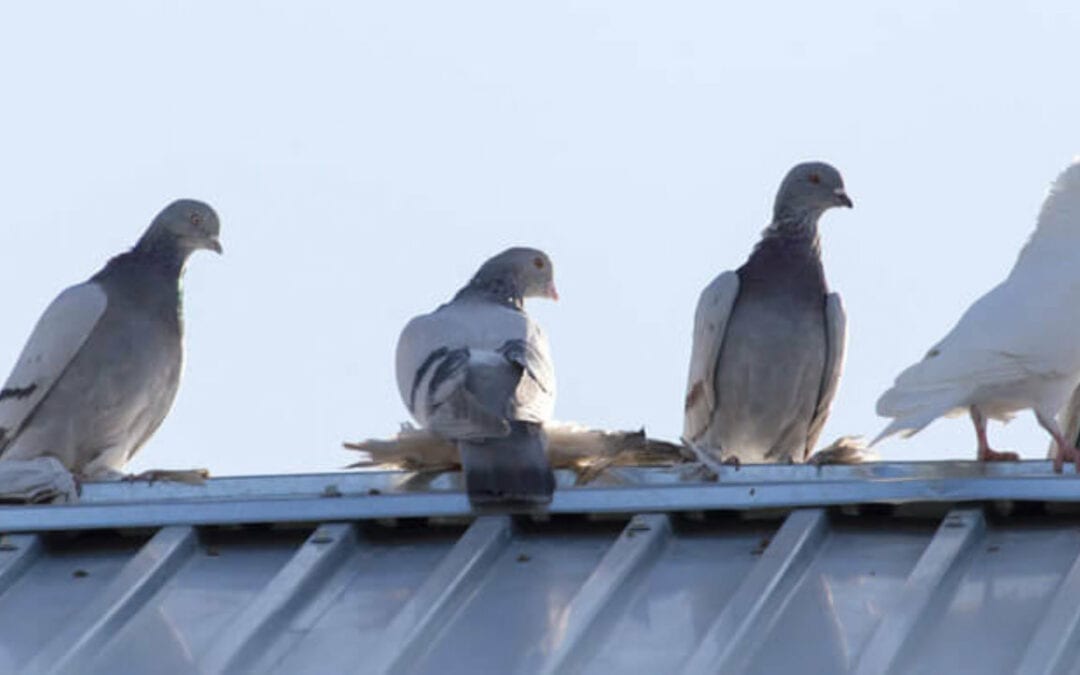
by Pigeon Patrol | May 10, 2021 | Bird Law, Pigeon Droppings, Pigeon Patrol's Services, Pigeon Spikes, Pigeons
Pigeons are bad news. While most homeowners don’t think twice about a few birds sitting on top of their home’s roof, they should when it comes to these “flying rats.” Pigeons can be a destructive pest, and their nests and droppings can damage your roof.
When you have pigeons on your roof, call KY-KO Pest Prevention to schedule your free pest inspection here in the Valley. We’re experts in humane pigeon control and removal, and we’ll get rid of the birds without any mess or fuss.
Dealing with pigeons on your roof
Unless you’re a business or commercial space, most homeowners don’t see pigeons as that big of a problem, or a threat like scorpions or rodents are. However, even if they’re not inside your home, pigeons can do serious damage.
1. Pigeon droppings are bad for your roof
Pigeon droppings naturally have high acidity, which actually is the case with most bird droppings. In fact, the acid content in them is so strong that it can cause damage to most roofing materials, particularly the underlayment of your roof.
If these droppings are left on the roof to accumulate, they’ll add to the wear-and-tear experienced by your roof. Here in Phoenix, your roof is already under assault from the elements, including the summer sun and the monsoon rains. Let KY-KO help you with pigeon problems, so that your home has one less thing to worry about.
2. Pigeon nests block water from moving off your roof
In addition to the problems caused by pigeon droppings, these birds also build their nests in roof drains, corners, and rain gutters. When the rain comes, these nests act as dams, blocking water from moving off of your roof and leading to the accumulation of water, wastage, and debris.
Severe cases of this issue can lead to roof collapses, as the continuous accumulation of water and dirt on the roof adds to the weight. The presence of pooled water is also not good for your roof’s structural integrity.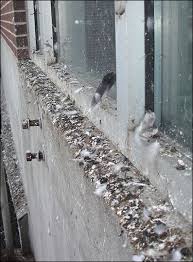
3. Pigeons will make a mess of your home and yard
For anyone who has parked their car in a public place and come back hours later to a mess, you know what this means. Left unchecked, pigeons will not only make a mess of your roof, but also your yard, your landscaping, your cars in the driveway—you get the idea.
Don’t have your home be the one on the block with obvious pigeon problems. Call KY-KO, and we’ll work on implementing a safe and humane way to keep pigeons away from your home.
For humane pigeon control and removal
Never take a pigeon infestation lightly. Given enough time, these birds can cause serious damage to your roof if you do not deal with them at the right time.
Source
Pigeon Patrol Products & Services is the leading manufacturer and distributor of bird deterrent (control) products in Canada. Pigeon Patrol products have solved pest bird problems in industrial, commercial, and residential settings since 2000, by using safe and humane bird deterrents with only bird and animal friendly solutions. At Pigeon Patrol, we manufacture and offer a variety of bird deterrents, ranging from Ultra-flex Bird Spikes with UV protection, Bird Netting, 4-S Bird Gel and the best Ultrasonic and audible sound devices on the market today.
Voted Best Canadian wholesaler for Bird Deterrent products ten years in a row.
Contact us at 1- 877– 4– NO-BIRD, (604) 585-9279 or visit our website at www.pigeonpatrol.ca
Pigeon/Pigeon Patrol / Pigeons Roosting / Vancouver Pigeon Control /Bird Spikes / Bird Control / Bird Deterrent / Pigeon Deterrent? Surrey Pigeon Control / Pest /Seagull deterrent / Vancouver Pigeon Blog / Birds Inside Home / Pigeons in the cities / Ice Pigeons/ What to do about pigeons/ sparrows , Damage by Sparrows, How To Keep Raccoons Away, Why Are Raccoons Considered Pests/ De-fence / Pigeon Nesting/ Bird Droppings / Pigeon Dropping/ woodpecker control/ Professional Bird Control Company/ Keep The Birds Away/ Birds/rats/ seagull/pigeon/woodpecker/ dove/sparrow/pidgeon control/pidgeon problem/ pidgeon control/flying rats/ pigeon Problems/ bird netting/bird gel/bird spray/bird nails/ bird guard
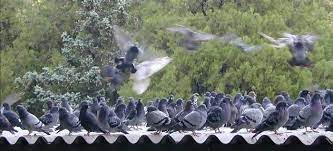
by Pigeon Patrol | May 10, 2021 | Bird Deterrent Products, Bird Law, Bird Netting, Bird Spikes, Columbidae, Pigeon Predators, Pigeon Spikes
Most of us love having backyard birds to watch and to feed. The music of songbirds is a sure sign of spring. On the other hand, bird damage to lawns can be extensive. If you’re finding small holes in your grass and you see a lot of birds around, the damage is probably caused by birds foraging for food. There are some ways you can keep birds from digging up lawn and grass. Read on to learn more.
Why are Birds Digging up my Lawn?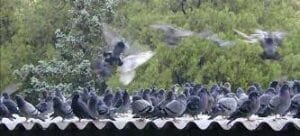
It’s not hard to identify bird damage to lawns. If you see a lot of birds in your yard and you find small, about one-inch (2.5-cm.) holes in the turf, it’s most likely bird-related damage. What are birds digging for in your lawn? The phenomenon of birds digging holes in lawns has an easy explanation: food. They’re looking for tasty snacks, so if you’re seeing a lot of bird damage, it means you have an insect problem. Basically, your lawn is the best restaurant around because it has so many bugs. Birds are simply foraging for grubs, worms, and insects. The good news about this is that the grubs and insects will actually do more damage to your lawn than the birds will, and the birds are helping you control the population.
How to Keep Birds from Digging up Lawn
If you want to avoid the bird damage of small holes all over your lawn, you have to get rid of the insect pests. To get rid of your bug problem, invest in a pesticide, preferably something natural. You can either have it applied by a professional lawn company or you can do it yourself. It is important to time the application. If you have grubs, for instance, you need to apply in late spring or early summer. It’s also important to time application to avoid harming the birds. Apply the pesticide in late afternoon so it will be dry by the next morning when the birds reappear to search for breakfast. If you prefer not to have birds at all around your property, there is little you can do but you can try using a few scare tactics that may keep the birds away.
Source
Pigeon Patrol Products & Services is the leading manufacturer and distributor of bird deterrent (control) products in Canada. Pigeon Patrol products have solved pest bird problems in industrial, commercial, and residential settings since 2000, by using safe and humane bird deterrents with only bird and animal friendly solutions. At Pigeon Patrol, we manufacture and offer a variety of bird deterrents, ranging from Ultra-flex Bird Spikes with UV protection, Bird Netting, 4-S Bird Gel and the best Ultrasonic and audible sound devices on the market today.
Voted Best Canadian wholesaler for Bird Deterrent products ten years in a row.
Contact us at 1- 877– 4– NO-BIRD, (604) 585-9279 or visit our website at www.pigeonpatrol.ca
Pigeon/Pigeon Patrol / Pigeons Roosting / Vancouver Pigeon Control /Bird Spikes / Bird Control / Bird Deterrent / Pigeon Deterrent? Surrey Pigeon Control / Pest /Seagull deterrent / Vancouver Pigeon Blog / Birds Inside Home / Pigeons in the cities / Ice Pigeons/ What to do about pigeons/ sparrows , Damage by Sparrows, How To Keep Raccoons Away, Why Are Raccoons Considered Pests/ De-fence / Pigeon Nesting/ Bird Droppings / Pigeon Dropping/ woodpecker control/ Professional Bird Control Company/ Keep The Birds Away/ Birds/rats/ seagull/pigeon/woodpecker/ dove/sparrow/pidgeon control/pidgeon problem/ pidgeon control/flying rats/ pigeon Problems/ bird netting/bird gel/bird spray/bird nails/ bird guard

by Pigeon Patrol | May 10, 2021 | Bird Law, Bird Spikes, Pigeon Control, Pigeon Droppings, Pigeon Patrol's Services
Color of Pigeons
Usually bluish-gray with black bands and reddish feet.
What does a pigeon look like?
Pigeons have broad and pointed wings, with small heads and short legs. They also have a wide and rounded tail. Their coat is blueish grey. They have a soft voice with guttural series of rolling coos.
Where are pigeons found?
Originally found wild in Europe, North Africa, and western Asia, feral pigeons have become established in cities around the world. The lack of adequate sanitation, deliberate feeding of the birds by humans, and “cliff-type” nesting sites on older buildings are the principal factors that attract pigeons to cities.
They will inhabit roofs, ledges, drain spouts, lofts, attics, caves, etc. They also frequent parks and sidewalks, where they become habituated to people feeding them. Pigeons are mainly creatures of habit and tend to feed, nest, and roost in the same place day after day.
Pigeons are a pest in most urban areas in the US. On the West Coast our local pest control specialists find pigeons affect many of our customers in cities such as Boise, Roseburg, Salinas, Spokane, Novato, and Palm Springs.
What do pigeons eat?
These bird-brained beauties also eat livestock manure; they’re not picky, and actually pretty disgusting. (But please don’t feed the birds. They do carry diseases.) Other favorite treats include seeds, grains, some fruits and green feed; but will feed on insects.
Pigeon life span
Pigeons pair for life, which may last for 15 years or longer. In urban environments, they may live for 3-4 years. Pigeons have a hearing range close to humans, but they have a poor sense of taste and smell. Remember—they eat manure. They also exhibit distinct behavioral patterns like nesting, feeding, roosting, and loafing. Nesting and roosting sites (places where they sleep or rest) may occur in the same area or be as far as 5 miles apart.
Breeding occurs year-round with 1-2 eggs per batch. The eggs hatch after 17-19 days of incubation, and young pigeons will leave the nest after 4 to 6 weeks. More eggs may be laid before the first young are gone. An adult pigeon eats about one pound of food a week. Pigeons, their nests, and droppings are of major concern because 50 or more diseases and ectoparasites are associated with them.
Diseases spread by pigeons
Pigeons are of great medical concern because more than 50 diseases and ectoparasites are associated with them, which leads to their description by non-romantics as flying rodents. Pigeon nests and droppings will also lead to dermestid beetles, flies, clothes moths, and stored product pest infestations within buildings.
-
Asthma – bird dropping can dry up and become dust. Once inhaled, this can trigger asthma attacks.
-
Salmonella – also known as food poisoning, but droppings can lead to the contamination of food.
-
Listeriosis, histoplasmosis, cryptococcosis – all fungal diseases that can come from growing on pigeon droppings.
-
Diseases from parasites – pigeons often carry ticks and fleas which can lead to things like Lyme disease and other illnesses associated with those pests.
Signs of a pigeon problem
How do you know if you have just a few pigeons or if you have a serious problem? Well, there are signs that the pigeons around your property may be causing problems. They include:
-
Large numbers of birds – just take a look around your property and see how many pigeons there are. Once one decides to set up shop, others are likely to follow. Are there a lot of birds on the ground? Are there more roosting above? Are people having trouble just walking through the area because of the number of birds?
-
Nesting material – pigeons use sticks, twigs, branches, leaves and even garbage to make up their nests. Is there an increased number of this material lying around? Pigeons are not famous for their neatness, so if there is an increase of debris, it could be from too many pigeons trying to nest.
-
Droppings – pigeons are rather notorious for the deposits that they leave behind. Are there so many that it makes it hard to walk? If so, time to call in the pros.
How to keep pigeons away
Got pigeon issues? Due to the problems that can come with these birds, you should have an infestation addressed right away. There are ways to keep pigeons away, such as spikes. Read more about these techniques below. Plus, you should make sure pigeons cannot get to standing water or food on your property. Get rid of garbage or food that has been spilled, so pigeons may find a spot less appealing.
Pigeon control methods
There are many techniques for excluding pigeons from an infested structure. Exclusion strategies include structural modification, bird netting, plastic and metal spikes, monofilament and steel lines, and trapping. In addition, gels, paste, and liquids can also be used for excluding the birds from the structure.
Structural modification: Birds like to land on flat surfaces. When the building ledges are angled (45 degrees), it prevents birds from landing on building edges. Sheet metals, styrofoam blocks, wood, stone, and other materials can be used to give the desired angle.
Bird netting: There are several types of bird nettings that can be used for exclusion. In general, netting provides the best long-term control in keeping the birds out of a structure. In warehouses and commercial buildings where bird activity is a major concern, bird nets can be used to prevent the birds from getting into overhead pipes, roof air conditioning units can be netted off from the birds, etc.
Plastic and metal spikes: Spikes can be used as a physical barrier in preventing the birds from landing on an area, such as perching on ledges and beams of buildings. Spikes have sharp pointed edges extending out at angles. They can be installed around ledges, roof peaks, eaves, window sills, or any places that are prone to roosting. Because netting and spikes are more effective long-term control methods, they are the preferred methods.
Pigeon repellent
Pigeon repellents are available in different formulations such as gel, paste and liquids. They differ considerably in cost, effectiveness, and texture (thick and tacky, jelly like or viscous).
Choose the one that works best based on the experience. These repellents are not non-toxic and because of their “sticky” properties cause the birds to move elsewhere.
How to get rid of pigeons
If you’re dealing with pigeons, you should contact a pest professional to figure out how to eliminate these pests. As you may have noticed, pigeons can get droppings on buildings, damaging the appearance of these structures. Their droppings can also pollute zones of human activity as well as food. A Western Exterminator expert can ascertain how to handle the situation and help you know how to inhibit these birds for the future.
Bird control solutions from Western Exterminator
Pigeons aren’t the only birds home and business owners need to be concerned about. Seagulls and starlings are known to cause damage and spread disease as well. With proper identification, our specialists can create bird control plans specifically made for you to ensure your property is bird-free.
Pigeon Patrol Products & Services is the leading manufacturer and distributor of bird deterrent (control) products in Canada. Pigeon Patrol products have solved pest bird problems in industrial, commercial, and residential settings since 2000, by using safe and humane bird deterrents with only bird and animal friendly solutions. At Pigeon Patrol, we manufacture and offer a variety of bird deterrents, ranging from Ultra-flex Bird Spikes with UV protection, Bird Netting, 4-S Bird Gel and the best Ultrasonic and audible sound devices on the market today.
Voted Best Canadian wholesaler for Bird Deterrent products ten years in a row.
Contact us at 1- 877– 4– NO-BIRD, (604) 585-9279 or visit our website at www.pigeonpatrol.ca
Pigeon/Pigeon Patrol / Pigeons Roosting / Vancouver Pigeon Control /Bird Spikes / Bird Control / Bird Deterrent / Pigeon Deterrent? Surrey Pigeon Control / Pest /Seagull deterrent / Vancouver Pigeon Blog / Birds Inside Home / Pigeons in the cities / Ice Pigeons/ What to do about pigeons/ sparrows , Damage by Sparrows, How To Keep Raccoons Away, Why Are Raccoons Considered Pests/ De-fence / Pigeon Nesting/ Bird Droppings / Pigeon Dropping/ woodpecker control/ Professional Bird Control Company/ Keep The Birds Away/ Birds/rats/ seagull/pigeon/woodpecker/ dove/sparrow/pidgeon control/pidgeon problem/ pidgeon control/flying rats/ pigeon Problems/ bird netting/bird gel/bird spray/bird nails/ bird guard


